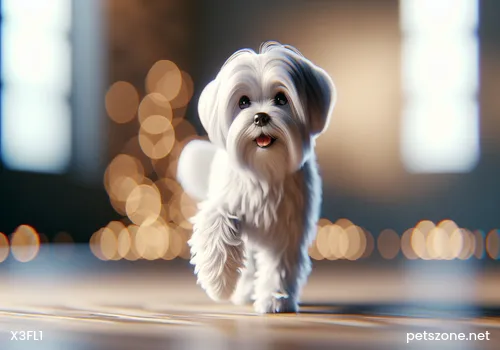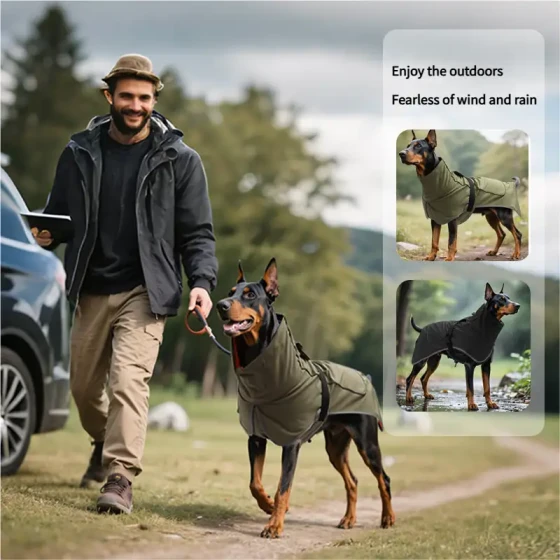Several Key Stages of Puppy Growth That Need Attention

First Stage From Birth to 21 Days Old
Characteristics: Puppies are born from the uterus. They cannot see or hear, cannot regulate their body temperature by themselves, and cannot defecate without external stimuli, entirely relying on the mother dog or a "surrogate mother." At this stage, there is no emotional development, social contact, or learning behavior occurring. Whether asleep or awake, the puppies' brain waves remain stable. For hunger, cold, and touch, puppies respond only reflexively. They huddle together for warmth; when too hot, they spread out but cannot regulate their body temperature by shivering or other means. During this nursing period, puppies crawl forward and backward, sway their heads left and right, and emit cat-like meows or vibrato repetitive actions. These natural movements exercise their muscles and nervous system and promote inner ear development.
What breeders should do: Keep the nursing mother dog happy, healthy, and on a well-balanced diet. Her good physical and mental condition provides everything the puppies need at this stage.
Pick up puppies very slowly, gently, and carefully. Subtle stimulation to the puppies' nervous systems after two weeks of age is beneficial: gently turn the puppies over with your hand, lightly press the skin on their ears, and hold the puppies by their spine for a few minutes daily. Puppies should gain weight every day, making this a great time to hold each puppy. This is not a period suitable for socialization or training. Mild stress can assist brain cell development.
What breeders should do: Refuse visitors during this period. Avoid anything that could stress the nursing mother dog (guests, parties, home repairs, etc.). Also, try not to move the puppies or separate the mother dog from her offspring. If the puppies or mother dog need a veterinarian, try to arrange for the vet to visit. Avoid public events; this is not a good stage to take a puppy to dog shows by camper, trailer, or RV.
13~21 Days Transitional Period
Characteristics: Eyes and ears open; puppies slowly begin to respond to light, movement, and sounds. As puppies become aware of their environment—their mother, littermates, and other objects—they become more active. Puppies may also show fear of humans at this stage. These reactions are still responses to stimuli rather than socialization results and emotional contact.
Puppies try to stand but still crawl back and forth. By the end of this period, they may try to climb out of the whelping box.
What breeders should do: Place toys as obstacles for puppies to climb over or arch. This helps puppies develop spatial awareness. Some puppies may start brief interaction with toys by the end of the third week. Continue holding puppies gently daily. Puppies grow very quickly and need frequent brushing with a soft brush. Likewise, this period is suitable for stimulation but not training.
What breeders should avoid: Avoid loud noises and sudden movements that could frighten puppies during their auditory and visual development. If you must change the puppy's environment, this period is suitable for doing so. Do not separate puppies from their nursing mother.
Second Stage 21~28 Days Old
Characteristics: A critical stage of rapid sensory development. Puppies are very alert to their surroundings and easily startled by sudden noises and movements. During this period, they can recognize the breeder and other people who appear gently and frequently. However, they have lost the natural immunity from the nursing stage. Negative experiences can easily imprint on basic behaviors. Social influence begins during this week.
Head-swaying and crawling behaviors similar to the nursing stage stop. Puppies become more active and walk much more smoothly. The body changes rapidly. Brain waves show significant changes, and puppies can now learn from experience and remember what they have learned.
What breeders should do: Introduce new tactile sensations into the puppy box. For example, puppies enjoy burrowing through shredded newspaper or climbing rolled towels or blankets. Continue holding them daily and add new sounds and lights to the environment. You can hold puppies outside the box on a surface different from usual. Holding two puppies together works much better than taking one alone.
What breeders should avoid: Avoid loud noises or sudden changes during this period. Negative experiences can have lasting effects. Avoid using noisy devices near puppies such as vacuum cleaners, hairdryers, electric shavers, etc. Postpone household work. Ask scheduled clients or curious friends to wait until puppies are at least four weeks old before visiting. Do not move puppies or separate them from their nursing mother during this week.
Third Stage 21~49 Days Old
Characteristics: Social awareness emerges, learning to be a dog (note: the first week of this crucial stage overlaps with development in the second stage). Gradually enthusiastic about play attack games. Puppies begin learning problem-solving abilities, body coordination, and bite inhibition. The mother dog starts warning puppies to teach rules. During this stage, puppies begin running to their bed, box, or pen corners to defecate. Starting housetraining!
What breeders should do: Keep puppies together as if they were just born, allowing the mother free access to their area.
During the 4th week (21-28 days), do not move the mother dog and start offering food to puppies. You can feed the mother dog and her puppies simultaneously in the puppy box. Gradually strengthen sensory experiences (refer to the second stage notes). Breeders and household members continue holding puppies daily.
During the 5th week (28~35 days), you can take puppies outdoors. If you cannot provide a toilet-like location, take them outside to eliminate after walks or meals. Start holding puppies individually away from their mates and mother for at least 10 minutes daily. Family members, friends, neighbors, or future owners can assist in this process. If 10 minutes is too long, start with 5 minutes. Daily separation from mates and mother is very important.
During the 6th to 7th weeks (35~49 days), increase brief sensory experiences like car rides. Introduce puppies gradually to vacuum cleaners. Use food or other attractive items to start simple routine training. Begin training puppies to stand on grooming tables for inspection or brushing. This is a pre-socialization stage. Increase exposure to strangers, especially children. Puppies that interact pleasantly and respectfully with well-mannered adult dog “uncles” and “aunts” will have better behavioral improvements—using tunnels, thick cardboard boxes, doors, stairs, fences, poles, and so on. Encourage puppies to pass through obstacles with food as a reward.
What breeders should avoid: Do not separate puppies from the litter during this period! Do not fully remove the mother dog. Puppies may show incorrect play aggression, mistakes in designated elimination, or coprophagia.
Fourth Stage 49 Days~12 Weeks Old
Characteristics: Expand social contact and restrict departure from the litter. Mental capacity is fully formed, though puppies lack experience. This is the best time to teach new things. Indeed, puppies learn fastest during this period. Research shows this rapid learning phase is when behavior is easiest to shape and regulate. Training during this time is accompanied by increased brain cells in relevant areas, objectively improving learning ability. Bladder and bowel control develop, and puppies can sleep through the night without accidents.
What breeders should do: Between 49~56 days, expand the puppies' activity area as much as possible. Group several dogs in small groups, rotating play and sleep. Puppies retained by the breeder can stay with other puppies. Maintain contact with other puppies. Continue individual brushing, playing, and training routines. Attitudes toward puppies should be gentle yet firm. Begin training simple commands like "sit," "lie down," "stand," "come," and "heel."
What breeders should avoid: During this period, do not isolate puppies from people or impose unnecessary activity restrictions (only necessary crates or fences). Avoid intensified fear responses caused by isolation. Note: The first fear imprint phase is from about 8~10 weeks. During this time, avoid relocating puppies and traumatic experiences like trimming or ear cropping.
After passing the first fear imprint period at 10~12 weeks, though still small babies, well-socialized puppies can be properly placed by breeders.
Fifth Stage 3~4 Months Old
Characteristics: With established social status, puppies enter a period of dominance desire. Puppies begin attempting to own their territory. This tendency becomes bolder. The body develops very quickly during this period.
What breeders/owners should do: Treat puppies as independent adult dogs. If they still live with the breeder, they should no longer live with other puppies, sleep separately in their own bed at night, and all training and care should be conducted individually.
Start dominance behavior exercises. Establish yourself and your family as higher in hierarchy—feed puppies after you eat; occasionally take away their food and toys during meals and playtime.
What breeders/owners should avoid: Do not use excessive force in play fights. Do not allow stray dogs to sleep on the bed with people. Absolutely prohibit chase games between puppies and children. Very importantly, during this period, do not pile puppies from the same litter together or put two unfamiliar puppies together.
Sixth Stage 4~6 Months Old
Characteristics: Teeth erupt and fighting phase. Puppies try to mark boundaries.
They may try to dominate human family members (especially children). May “forget” to eliminate in designated places.
This period is characterized by independence and wildness. In the puppies’ minds, the owner or breeder is no longer a “mommy” substitute.
What breeders/owners should do: Keep puppies on a leash when outside the fence. Continue recall training and frequently touch any part of the puppy’s body.
What breeders/owners should avoid: Never allow puppies off-leash under any circumstances. Do not chase puppies or engage in mutually chasing games.
Second Fear Imprint Period 6~14 Months Old
Characteristics: Sexual maturity and hormonal changes. Fear of new environments, objects, people, or other dogs. Male dogs start lifting their leg to urinate. Some dogs show no noticeable changes and pass through this stage quickly compared to most dogs, while others show unusually prominent behavioral changes during this stage.
Pay attention to your behavior: On one hand, excessive pampering and protective behavior can reinforce fear; on the other hand, avoid punishment-caused fear. Strive to treat fear behaviors with strict yet patient and friendly attitudes. Continue social activities with strangers and other dogs. During this fear imprint period, try to avoid or reduce particularly stressful or traumatic experiences for the animal.


-560x560.webp)
